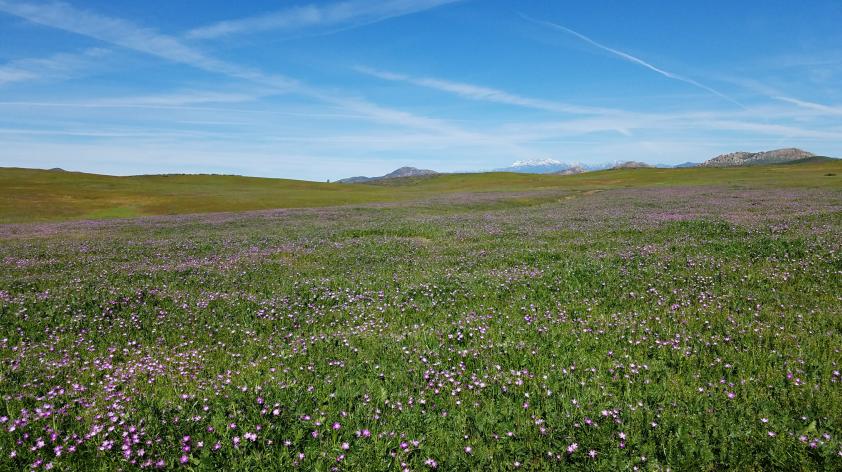
Field Notes from Super Bloom 2017
It’s a fact of life in California that most, if not all, of our valley and foothill grasslands have been invaded with exotic annual grasses such as foxtails (Bromus madritensis), ripgut brome (Bromus diandrus), and wild oats (Avena sp.). These species are strong competitors, and in the worst cases, they outcompete all the natives, converting the grassland to a tall, dense monoculture. When this happens, the grassland becomes uninhabitable by key species in the food web, such as California ground squirrel and western burrowing owl. (Hang in there with me, this story is going to take a positive turn.)
Not long ago, our understanding was that native perennial bunchgrass species comprised the foundation of pristine, uninvaded valley grasslands. This would have held true up to the introduction of annual exotic grasses, which arrived with white settlers 200 to 300 years ago. However… there was an evidence problem. The details didn’t quite add up. For example, if a restoration ecologist was trying to restore a grassland to its original species composition, there were only a few known native valley bunchgrass species for use. It seemed at times as though we were going to try to plant the entire state with purple needlegrass (Stipa pulchra).
Part of the problem is that so much of the original grasslands have been converted to various human uses (up to 98% of native grasslands by some estimates), that we just aren’t sure any more about the original state of California grasslands. But the short list of bunchgrass species is an outlier in the California Floristic Province, which is defined by its species diversity. The state of California is famous for over 100 species of lupine (Lupinus sp.) and for nearly 90 species of beardtongue (Penstemon sp.)! Considering the evidence in other plant families that the geological and climatic diversity of California is an evolutionary engine that churns out many new species over time, how could the valley grasslands realistically have been dominated by only a couple of native bunchgrass species?
The answer, which has really only emerged in our understanding of California grasslands relatively recently, is that grasslands may not have been defined by native bunchgrasses (Minnich 2008). The early explorers said as much, when they wrote journal entries detailing vast hillsides washed in colorful floral displays. The “grasslands” were forblands. Rather than being dominated by grass species, they were made up of dozens of flower species, and the palette changed depending on how far north or south or coastal or inland the grassland was located.
Although there are nearly no extant grasslands with intact species composition, there are pieces of forb communities left in partially invaded grasslands all around the state. Rainy seasons such as this past winter provide additional analogs for the idea of forblands in the remaining vernal pools and in the super-blooming deserts.
I’ve sampled local grasslands over the past several drought-stricken years, but last week in Riverside County I experienced something new. We were sampling a grassland owned by the County and set aside for conservation values. My task was to sample the vegetation around an occupied burrowing owl burrow. I laid down the first line transect and began taking readings. Usually, transect data are full of detections of exotic grass and forb species. In this grassland, though, I started reading points that consisted only of native forb species. It was surprising enough that I stopped, straightened up, and made my data recorder shake hands with me, in order to mark the moment.
The sun was shining, the temperature was warm and the wind was soft and gentle. It was a perfect spring day, and I was in a gorgeous California forbland. Of course, we also recorded several exotic grass and forb species, but… it was close enough. It’s no accident that our survey results came after abundant winter rains. One of the adaptations to drought that native species have is the ability to respond quickly and strongly when optimal growing conditions occur. This spring is special in that the native seedbank, which can lie dormant through drought, has been activated to a degree that we haven’t seen for several years.
It can be easy to dismiss the ecological value of heavily invaded grasslands, so that perhaps the loss of such places to development projects carries less emotional import. However, this spring is a reminder of the value of all our remaining grass/forblands. Let’s be glad for the lands that have been secured in perpetuity, and seek opportunities to reduce development impacts on other open lands.
(Photo credit: Colleen Wisinski)













